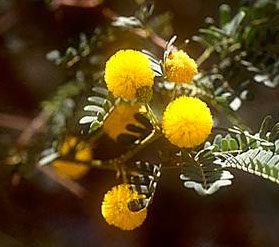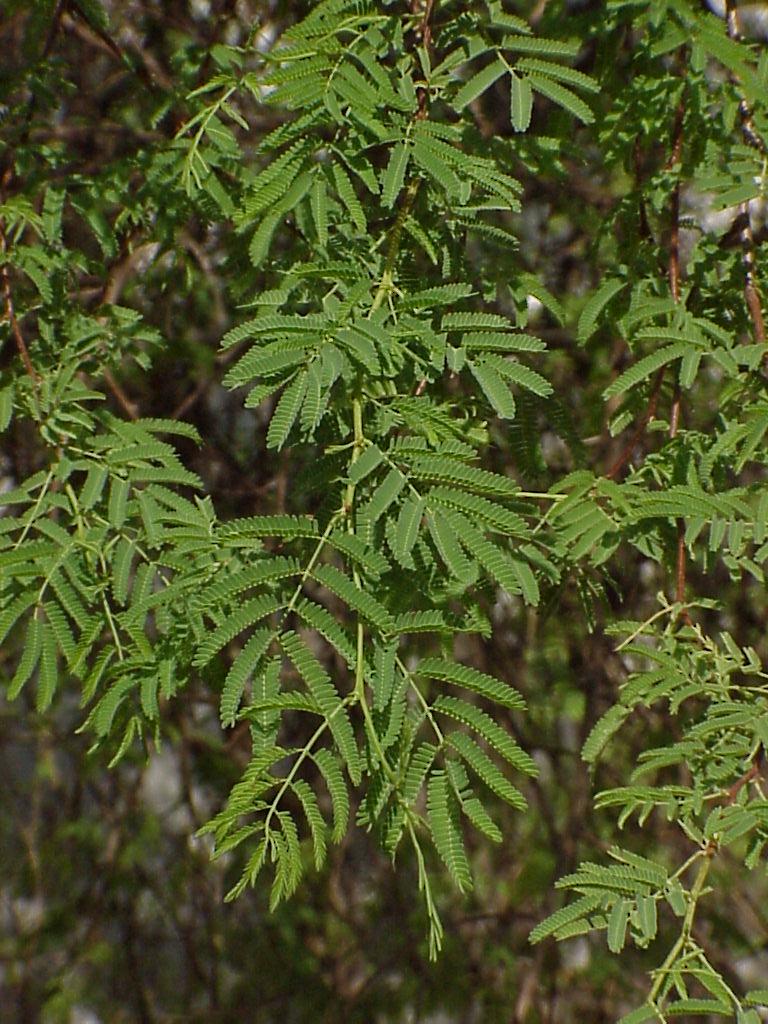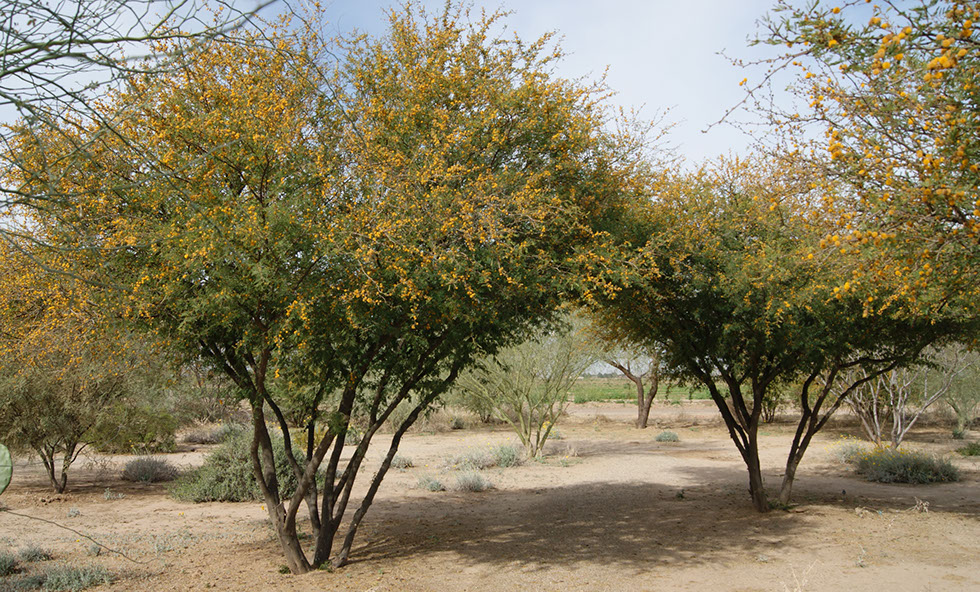


Acacia smallii 'AZT'
'AZT' Sweet Acacia
Foliage: Semi-Deciduous
Mature Height: 15’ - 30’
Mature Width: 15’ - 30’
Growth Rate: Fast
Hardiness: 15-20 degrees F
(see below)
Exposure: Full Sun
Leaf Color: Green
Shade: Filtered
Flower Color: Yellow
Flower Shape: Ball
Flower Season: Spring
Thorns: Yes
Propagation Method: Cloning
Sizes Available: #24 and #45



Acacia smallii ‘AZT™’, AZT™ Sweet Acacia is the most recent addition to our expanding inventory of cloned desert trees. It possesses the best qualities of two other popular desert trees, Blue Palo Verde and Thornless Mesquites. It brings a brilliant floral display to the landscape, like those of Blue Palo Verde, in combination with a lush, deep green canopy, like Thornless Mesquite. With these qualities, and wonderfully fragrant flowers, it’s not surprising that it is among the most widely used desert trees. Showy, fragrant flowers, upright stature and rapid growth rate makes it desirable for commercial and residential landscapes. It is used as a theme tree in streetscape planting or at development entries but is probably used most often as individual accent trees in mixed desert planting.
Plant taxonomy is the science of organizing plants into grouping or categories and giving them names (a Latin binomial), based on agreed upon physical characteristics. Originally Sweet Acacia was named Acacia farnesiana after the 17th century Roman Cardinal Odoardo Farnese. Sweet Acacias have been found in tropical and semi tropical climates all over the world, including North America, South America and Africa. Since the late 1960's plant taxonomists have been troubled by the wide variety of horticultural characteristics (flowering periods, cold hardiness etc.) exhibited by the large and geographically dispersed population of trees identified as Acacia farnesiana. Over the last 20 years several attempts have been made to address this variability leading to Sweet Acacia being identified as up to three differently species; A. smallii, A. farnesiana and A. minute. In 1969, it was proposed that Sweet Acacias actually represented two different tree species. Acacia smallii was proposed as the name for all the Sweet Acacias occurring from California to western-most Florida and Acacia farnesiana for those trees found in the balance of Florida and the Caribbean.
The horticultural characteristic of greatest interest to landscape professionals in the desert southwest is cold hardiness. Experience over the last 10 to 15 years had shown that Acacia farnesiana is severely (sometime fatally) damaged by temperatures below 20-25 degrees F. In contrast, Acacia smallii appears hardy to about 15 to 20 degrees F and survives most central and southern Arizona and southern California winters injury free. While there are other physical (tree structure) and botanical distinctions between these two species, the greater cold hardiness of Acacia smallii is the main reason it has become the more popular of the two Acacia species. The need for consistent, predictable cold hardiness make Sweet Acacia and ideal candidate for clonal propagation and AZT began the search for Mother trees that possessed sound branch and rooting structure, flowering characteristics and possessed reliable cold hardiness to at least 20 degrees F.
Historically, seed grown Sweet Acacia have exhibited high variability of critical horticultural characteristics. Some common variations, like canopy and leaf density, bark texture, and flowering have little impact on tree longevity or durability. Wide and significant differences in cold hardiness, from tree to tree, have lead to catastrophic damage to some trees during severe desert freezes. Like all Variety ‘AZT™’ selections, Acacia smallii, ‘AZT™’ is propagated from cuttings (cloned) and is the product of an extensive screening process that begins with horticultural qualities, like cold hardiness, rooting characteristics and overall durability. Once these qualities are identified, we look for potential Mother trees whose physical appearance reflects the natural beauty that have made Sweet Acacia a landscape staple in desert landscapes. Acacia smallii ‘AZT™’ consistently exhibits cold hardiness down to 15-20 degrees F.
The literature describes mature Sweet Acacias at a height of 15’ to 30’. Our experience with Acacia smallii ‘AZT™’, AZT™ Sweet Acacia has been that trees may reach 35’ to 45’ and may be 30’ wide. Mature specimens are best adapted to full sun, well draining soils and occasional deep irrigation(s). They tolerate both desert and lawn plantings. Rapid tree growth coupled with the tendency to produce new branches all along the trunk make regular, moderate pruning a maintenance must. Leaves are made up of 10 to 20 pairs of tiny oval leaflets giving the leaf canopy a delicate, fern-like appearance. Unpruned mature trees provide fairly dense shade and inhibit the growth of flowering understory plantings. Acacia smallii ‘AZT™’, AZT™ Sweet Acacia is semi-deciduous. In warmer winters or in certain microclimates trees may retain a majority of the leaf canopy. Leaves are shed in spring with the resumption of growth.
Acacia smallii ‘AZT™’, AZT™ Sweet Acacia is one of the first desert trees to bloom. The bloom period seems to be somewhat variable depending on the severity of winter cold temperatures. In years with mild fall weather flower buds may appear on some trees in November and December with blooms persisting into late winter and early spring. Other specimens may not begin blooming until mid to late spring with flowers lasting until April to late May. With Acacia smallii ‘AZT™’, AZT™ Sweet Acacia, flowers appear February March and continue to be produced until approximately April. Mature seed pods are dark brown, cylindrical, 2 to 2 1/2 long and 1/4 to 3/8" in diameter.
Acacia smallii ‘AZT™’, AZT™ Sweet Acacia, takes its common name from the unmistakable fragrance of its bright yellow ball flowers. It brings color, shade and a desert character to any landscape setting. Sweet Acacia like other desert natives have slender, white to gray thorns along the branches. These thorns are conspicuous, readily visible and pose little risk to pedestrians. They are frequently used in street and sidewalk plantings as well as in parking lots. Their abundant shade and moderate stature contributes to their use in courtyards, patios, seating areas and near building entries. If desired, thorns on lower branches are easily removed with hand pruners.
Like most desert adapted species, multiple trunked and low branching specimens’ best capture the natural character of the tree and improves resistance to wind damage. These spreading, mature specimens maximize the flower display and the accompanying fragrance.
Pruning and shaping Sweet Acacias, especially during the first few years, is essential for establishing the form and structure of the mature tree. Because of their many desirable qualities (flowers, shade, dark green canopy) these trees are used in a wide array of landscape settings. When designing this tree into the landscape appreciate that mature specimens will generally be as wide as they are tall and, with optimal growing conditions, can grow to 30 feet. Rapid tree growth coupled with the tendency to produce new branches all along the trunk make regular, moderate pruning a maintenance must. This succulent growth is ideally removed in the ½" to 3/4" diameter stage when it is easily cut with hand pruners or loppers.
Arid Zone Trees distributes Sweet Acacias in Arizona, Nevada and California. The various communities within these states experience different low temperature extremes in any given winter. As a result we only grow Acacia smallii, and we constantly are looking for selections to propagate that have exhibited the highest levels of cold hardiness that we can identify.
Cultural Practices:
Foster the development of a more dispersed root system and reduce the risk of wind throw by arranging irrigation emitters at varying distances from the trunk to encourage roots to "seek out" water and nutrients. Irrigation emitter arrangement along with other information on irrigations practices for desert trees can be found at Irrigation Practices for Desert Trees.
Prune as needed to reinforce the structure and form of the tree. Periodic thinning is the most desirable method of pruning. Avoid hedging or heading back desert species, as this will only stimulate excessive branching. Do not remove more than 30% of the canopy during the summer as this can lead to sunburn injuries that can later be invaded by wood boring insects. Always use clean, sharp tools that are cleaned regularly in a 10% solution of bleach. For detail pruning guide see Pruning Desert Trees.
Periodically insect pests can be a problem on some desert trees. On young trees, insect infestation can slow typical seasonal growth. Inspect trees during the growing season for common garden sucking insects such as aphids, thrip, whiteflies or psyllids. During dry months, (May and June) in dusty conditions, spider mites can appear. Monitor for infestation and apply controls as needed. Spray applications of water or water and Safer Soap give short-term control (3 to 7 days) for small insect population. For heavy infestation or longer control use federally registered insecticides. A contact insecticide application will kill existing adults. An application with a systemic soil drench will provide 8 to 12 weeks control for any post application insect hatchings or migration of insects. Before using pesticide for the first time or on new plants or cultivar, treat a few plants and check for phytotoxicty. Always read label and follow label instruction before using pesticides. For pesticide control recommendations contact a licensed pest control advisor.

© Copyright 2000-2020 Arid Zone Trees